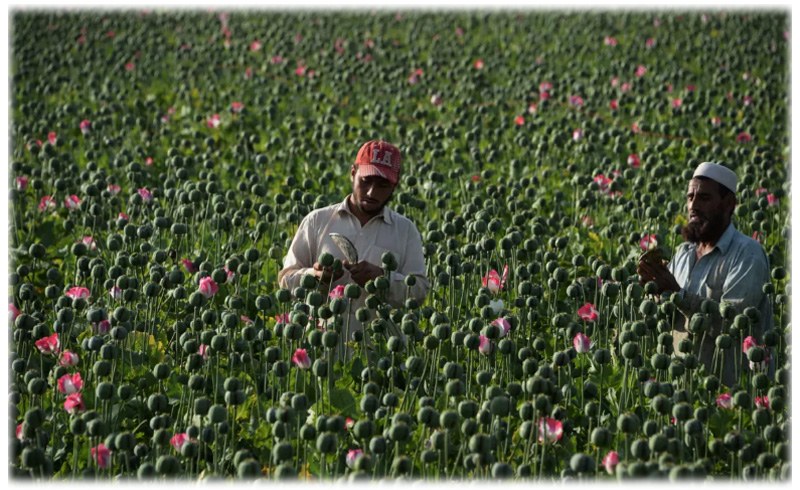 Pakistan
Pakistan Pakistan’s romance with narcotics isn’t just a drug problem; it’s a battle against poverty, corruption, and societal fissures.
Poppy cultivation, deeply embedded in its tribal lands, weaves a complex web of challenges demanding nuanced solutions. Beyond its national implications, the drug trade’s tendrils extend globally, with North America (Canada, the US, etc.) emerging as a significant final destination for these illicit substances. The far-reaching impact underscores the urgency of addressing not only local power structures but also the international dimensions that sustain and exacerbate the issue.
The fertile crescent stretching along the Afghan border has, for centuries, nurtured the poppy. While outlawed in 1979, the plant remains a lifeline for farmers struggling on barren soil. For them, a single harvest yields tenfold compared to traditional crops, a stark reality in the face of economic hardship.
But profit isn’t the sole seed sown. The “VIPs” – vested interest persons – act as parasitic tendrils, controlling the trade through armed militias and alleged high-level connections. Eradication efforts wither in the face of such deeply rooted power structures.
The nexus between the drug trade and the ISI (Inter-Services Intelligence) and the Pakistan Army has roots in historical events. An article from The Washington Post by John Ward Anderson and Kamran Khan sheds light on a pivotal moment. The then Prime Minister Nawaz Sharif was approached by the Pakistan Army Chief and the head of the intelligence agency, proposing a detailed “blueprint” for funding covert military operations through the sale of heroin. This revelation underscores the complicity of key state actors in perpetuating the drug trade in Pakistan.
A United Nations report highlighted that Pakistan serves as a crucial transit route for the smuggling of drugs worth $30 billion from Afghanistan, contributing to an annual illegal drug trade estimated at $2 billion. The heroin produced from poppy plants cultivated in northern provinces finds its way to the West, including the United States, Iran, China, Europe, and beyond. The remote tribal regions of the Northwest Frontier Province (NWFP) are vital hubs for opium poppy cultivation, posing challenges for law enforcement due to the flexibility of heroin laboratories operating between Pakistan and Afghanistan.
The roots of opium cultivation in NWFP are deeply embedded in the socio-economic fabric of the region. The Pashtuns, valuing land ownership, cultivate poppy as it thrives on their semi-barren land, providing substantial economic returns. Despite opium production being banned in 1979, the main obstacle remains the traders or “VIPs” (vested interest persons) acting as intermediaries between growers and large-scale distributors. Armed and often supported by private militias, these traders pose a significant challenge to the government’s efforts to curb opium production.
Efforts by the Pakistani government to combat opium cultivation include crop eradication programs and alternative development initiatives. However, these endeavors are hindered by limited resources and farmers’ reliance on opium as a primary income source, coupled with the fear of reprisals from traders. The alleged protection enjoyed by these traders from high-level government officials further complicates the fight against opium production.
Beyond opium, Pakistan faces pressing issues of drug abuse and trafficking involving marijuana, cocaine, and amphetamines. The majority of these drugs enter the country from neighboring nations, exacerbating the problem of drug addiction among the youth. With 7.6 million drug addicts in Pakistan, 78% of whom are male, the country is grappling with a rising addiction rate of 40,000 individuals per year, making it one of the most drug-affected nations globally.
Poverty, unemployment, and lack of education contribute to the growing drug addiction problem. Cannabis and heroin, due to their affordability, are widely abused in the country. In addition to law enforcement operations and border control measures, the government has initiated public awareness campaigns to combat drug abuse. However, these efforts are often hampered by limited resources, perceived corruption, and negligible cooperation from local communities.
Compounding the issue is the lack of access to treatment and rehabilitation services. The limited number of rehabilitation centers in Pakistan, coupled with a shortage of resources and trained staff, hinders effective drug addiction treatment. Moreover, a lack of awareness and understanding among the general population leads to stigma and discrimination against those struggling with addiction.
(Image and text courtesy: Khlsavox.com)
Support Our Journalism
We cannot do without you.. your contribution supports unbiased journalism
IBNS is not driven by any ism- not wokeism, not racism, not skewed secularism, not hyper right-wing or left liberal ideals, nor by any hardline religious beliefs or hyper nationalism. We want to serve you good old objective news, as they are. We do not judge or preach. We let people decide for themselves. We only try to present factual and well-sourced news.







